INTRO:
Shantae is one of those game IPs that have achieved cult classic status, with a profile that is high enough to motivate (and apparently finance) its maker to make another entry. The Pirate’s Curse is one such entry, and it so happens to occur close to WayForward’s foray into Kickstarter crowdfunding.
The Pirate’s Curse has more curvaceous artwork, more stories and more exposition about existing characters, as well as a different set of capabilities for Shantae this time around. As a Metrovania title, The Pirate’s Curse is more fulfilling than its predecessor Risky’s Revenge.
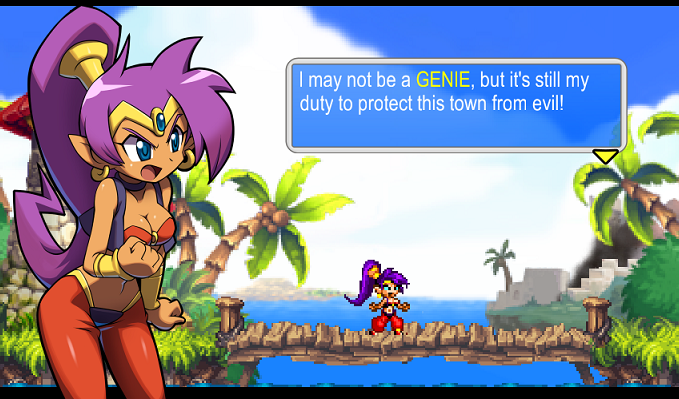
PREMISE:
(This review is written many years after the release of Risky’s Revenge and The Pirate’s Curse, so the spoiler clause should not apply here.)
At the end of Risky’s Revenge, Risky the self-proclaimed Pirate Queen has managed to partially achieve her revenge on Shantae for having ruined her plans for a war machine in the first game. Shantae has been stripped of her genie powers, thus losing her ability to transform and use most magic. However, Shantae is still the guardian of Scuttle Town, having retained her physical prowess and the peculiar capabilities of her hair.
Shortly afterwards, Scuttle Town has gotten itself into another crisis again, no thanks to its incompetent mayor and the power-hungry Sequin Land barons. However, this is a small problem compared to the impending calamity that Risky would reveal to Shantae (in not-friendly terms).
Speaking of which, the greatest contribution to the overall narrative of the series is the exposition on the impending disaster that Risky would warn Shantae about. Much of it concerns Risky’s past, such as the implication that Risky might be much, much older than she looks (or that she is not human in the first place).
Sequin Land has also been expanded. Although the locales which are shown in the first and second game are not all featured, there are islands other than the one that Scuttle Town is on in The Pirate’s Curse. On the other hand, most of them seem to be recycles of locales seen in the previous game.
The only locale with convincingly significant contribution to the narrative is Sequin Palace, home of Sequin Land’s monarchy. Unfortunately, there is a lost opportunity here to highlight the system of governance in Sequin Land, and, in particular, to introduce its monarch, the absent Sultana.
GAMEPLAY – OVERVIEW:
Like the previous entry in the series, Pirate’s Curse is a Metrovania game. However, since Shantae has lost her genie powers, her additional platforming capabilities are obtained through borrowing Risky’s pirate accoutrements; this is apparent from the cover art for the game. (Conveniently, there is a narrative excuse for Risky having lost her gear and Shantae finding them in secluded places.)
Typically, Shantae gains these additional capabilities gradually. These are used to overcome previously insurmountable obstacles and collect things. Further upgrades are obtained by purchasing them with currency that is collected throughout Shantae’s adventure.
The enemies in this entry are less stupid than the ones in the previous game. Compared to those in Risky’s Revenge, there are more enemies in Pirate’s Curse with scripts that let them pursue Shantae, or at least move and/or make attacks in her direction. Nonetheless, defeating them is a matter of observing their behaviour and countering them.
There are more details on the gameplay that will be explained in their own sections.
HEARTS:
As usual, hearts represent the amount of health that Shantae has remaining. Each quarter of a heart represents a hitpoint.
Some hits remove hearts and cause Shantae to stagger in place while invincibility frames protect her from further hits; this is the case for almost all contact damage from enemies. Some other hits are considered as heavy hits, and will fling Shantae a short distance away; however, these do not necessarily inflict more damage.
Hearts are restored by cartoon hearts that sometimes pop out of defeated enemies and broken loot jars, or by eating food items that Shantae can collect and hoard. Reloading a game save also restores all of Shantae’s health (which is a handy convenience to keep in mind). Occasionally, the player may also come across large golden-trimmed hearts which completely heal Shantae.
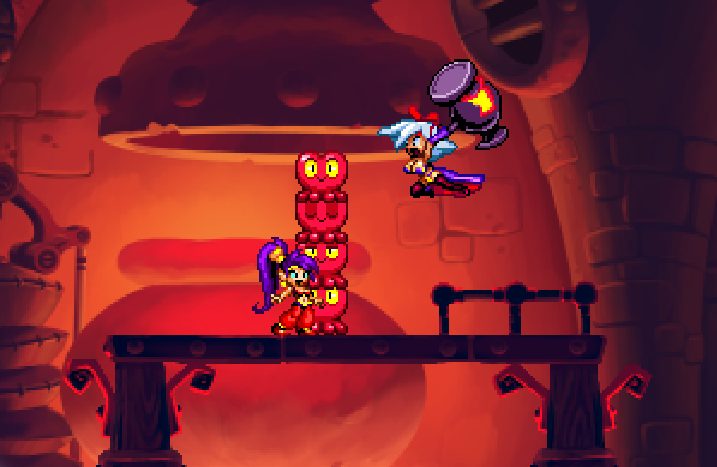
In this entry of the series, additional heart containers are obtained by collecting “Heart-squids”, which are another species of squids in addition to the ones seen in the previous games. Typically, these dim-witted creatures hang around obscured locations; the player should still be able to see glimpses of them, thanks to their very obvious profiles, bright colours and energetic demeanour. However, their retrieval requires the use of the aforementioned additional capabilities.
Some of them can only be obtained by finding hidden destructible obstacles, which will be described shortly.
DESTRUCTIBLES:
The previous games have some obstacles that can be destroyed by hitting them, such as illusory blocks that can be dispelled easily and rocks which can be smashed. Pirate’s Curse has these too, and they will be introduced to the player where relevant (usually when the player gains capabilities that allow Shantae to do so). In the previous games, these obstacles are generally visually obvious.
HIDDEN DESTRUCTIBLES:
Most of the time, WayForward includes the best Metrovania design practices in its Shantae games. However, there are some notoriously infuriating designs that get slipped in; one of them are visually obscured destructible obstacles with next to no hints that they are there.
Of course, Wayforward has given some thought to some of the hidden obstacles. In some cases, there are visual hints that they are around, such as cracks on walls in the foreground and glimpses of heart-squids or chests in seemingly unreachable alcoves. In some other cases, the player may have already collected the map for a locale, so consulting the map might provide the player with clues as to the presence of hidden destructible objects.
As for the rest of the hidden destructible objects, there are just no hints. The player has to rely on his/her suspicion and hit walls here and there; this is not always fruitful. In particular, testing walls with Shantae’s charge attack (which is granted by Risky Boots’ boots) can be tedious.
FOOD ITEMS:
In Risky’s Revenge, Shantae can carry around generic healing potions, which heal her completely when used. In addition to being aesthetically boring, they were also perhaps too convenient.
In Pirate’s Curse, the main healing items are food. There are four types of them, arranged in a sequence of increasing amounts of health restored. Incidentally, the latter ones are only useful after Shantae has accrued several heart containers over the base number. Like the potions, in-game time is conveniently paused when Shantae consumes the food.
There are other food items which do something other than healing Shantae. For example, there are bottles of “Monster Milk” (which might sound more than a little gruesome to some people); these are practically damage buffs, which are quite handy if there are gauntlets of enemies to bull through or bosses to fight.
All food items can be bought at the store in Scuttle Town, but they can also be obtained as loot from defeated enemies. In fact, the latter source is perhaps the better option for players who are frugal.
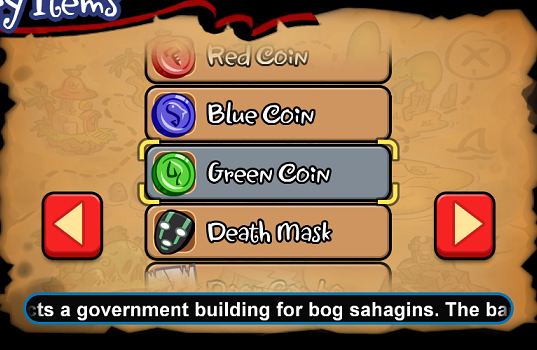
POTIONS:
Potions do return as well, actually. Furthermore, there is a variant called “Auto-Potion”, which is automatically used without having to access the inventory screen. However, they generally have to be bought; they are rarely, if not never yielded as loot.
PIRATE FLARES:
Risky is practically Shantae’s driver throughout most of the game; Risky uses her ship to ferry Shantae from one island to another. However, the default way to get off an island is to return to Risky’s ship, which can be tedious as it can involve considerable backtracking. Fortunately, there is the consumable item Pirate Flare, which the player can use to have Shantae somehow return to Risky’s ship immediately. (Presumably, Risky circumnavigates her ship around an island to a shore point that is closest to Shantae, but then, this game has a fantasy setting with magic.)
However, the Pirate Flares are very rare drops from enemies; more often than not, the player has to spend precious gems on buying them, which means less gems going into upgrades. (Of course, gems can be farmed.) Pirate flares also cannot be used underground or in lairs.
PIKE BALLS:
Pike balls return in this game. Like their previous incarnations, they help the player strike enemies which Shantae’s strictly lateral hair-whipping cannot hit, or just pile a lot of damage on tough enemies like bosses, for as long as they are orbiting around Shantae. As with the previous game, there are a few variants of pike balls, the more expensive ones being nastier than the cheaper ones.
BUBBLE SHIELD:
There are many enemies that use ranged attacks. Although Shantae can eventually gain the ability to use ranged attacks of her own (more on these later), it might be more prudent to close the distance and whip them, especially if Shantae’s damage output with her hair is greater than that of her ranged attacks. Therefore, there is the Bubble Shield, which conveniently blocks most ranged attacks (especially those that are obviously composed of colourful blinking projectiles).
SO MUCH AIR:
Players who have played the previous games might notice that Shantae’s jumps are much more controllable in this entry. It is much easier to air-strafe in this game than the previous one, which makes landing on moving platforms a lot easier than it was in the previous game. (There is also the fact that the narrow flying pillars in the previous game are not in this one.)
Interestingly, the player can have Shantae do an attack in mid-air and still can have her air-strafe; this cannot be done while on the ground, because her sprite is locked in place.
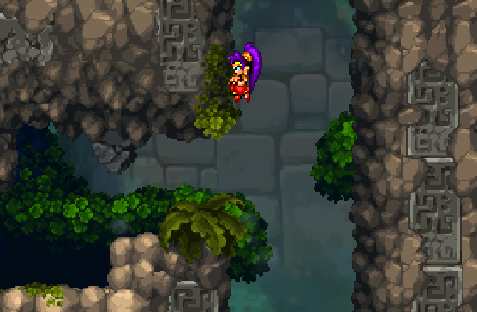
HAIR-WHIP:
As mentioned earlier, Shantae retained her peculiar hair after she lost her genie powers. She can defeat enemies by whipping them with it, and she can still “upgrade” her hair by purchasing and applying shampoo. However, functionally, her hair-whip works just like it had always been; there are no new capabilities that are exhibited by her hair.
RISKY’S GEAR - OVERVIEW:
As mentioned earlier, the Metrovania element of gaining capabilities to go to previously inaccessible while also gaining options for combat are represented by Risky’s pirate gear. They have been spirited away and kept in treasure chests deep in dungeons/lairs/dens. They have to be obtained in sequence; incidentally, the dungeon/lair/den that yields a piece of gear has to be navigated with the use of previously obtained gear.
After obtaining a piece of gear, there are usually segments where the player has to use it to get Shantae out of whatever level she is in. In addition, the boss monster on the island in which the piece of gear was found has to be defeated using that piece of gear (and sometimes the previous ones too).
After completing the first playthrough, “Pirate Mode” is unlocked. All of the gear is available right from the start. This mode is mainly for those who are gunning for the speed-run achievements and the wallpapers that they unlock.
FLINTLOCK PISTOL:
This is the first piece of gear to be found. It may be operated with a flint-lock, but for gameplay purposes, it may as well be a semi-auto handgun with unlimited ammunition.
Anyway, the pistol is Shantae’s main ranged attack; it is much faster to use than the fireball spell that was in the previous game. However, like the hair-whipping, it cannot be used on the move (unless the player fired it mid-jump, as mentioned earlier). Furthermore, its attack rate cannot be improved, unlike the hair-whip.
The pistol’s main use in the platforming gameplay is to hit switches or illusory obstacles from a distance. It has little other contribution.
TRICORNE HAT:
Risky’s signature tricorne hat can inflate itself, essentially acting like a parachute. Like Shantae’s jumps (and free-fall), the player has plenty of control over the movement of the parachuting. (Deploying the parachute also visibly raises Shantae’s sprite a little; this does contribute to platforming.)
The hat is also needed for the utilization of air currents (which are depicted by swirling leaves – even if there should not be any leaves around that can be blown by wind). The hat will move in the direction of the currents, which are generally upwards.
There are a few segments where the player needs to exercise some control over when to deploy the hat and when not to use it in order to navigate past obstacles and hazards that are somehow suspended in mid-air. Fortunately, deployment and retraction of the hat are speedy matters.
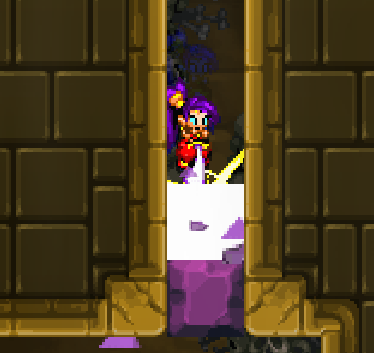
SCIMITAR:
The Scimitar is perhaps the oddest of Risky’s gear, though this is because of how Shantae uses it. Shantae can bring it out during mid-jump and point it downwards; obviously, anything below her would be struck by the business end of the blade. Shantae will rebound off the target, regardless of whether it is still alive or not. In the former case, the player could have Shantae bring the scimitar down on it again by entering another input to thrust downwards with the sword. If the scimitar hits ground instead, the rebounds end.
Unfortunately, the scimitar’s rebounds are not as controllable as the thrusts. This is because the rebound has an initial lateral momentum in the direction that Shantae is facing, which is not always desirable. The player could counter this by adding and holding down directional input before and during the rebound, but this also means that some of the effort in providing this input would be wasted on compensating for the initial lateral momentum.
In other words, the scimitar is nowhere near as controllable as Scrooge McDuck’s cane-hopping. Although having it designed as a complete knock-off of the latter would have been unseemly, this issue could have been addressed by increasing the vertical heights of the rebounds.
HIGH-HEELED CUFFED BOOTS:
Risky’s boots allow Shantae to charge with the Scimitar (which is obtained before the boots). After moving in a certain lateral direction for a while without stopping, jumping or getting hurt, Shantae’s sprite freezes into a certain pose. A bright blue outline also flashes around her sprite, accompanied by a chime. This is the player’s cue to trigger a charge, while holding down the directional movement input.
When charging, Shantae bursts through any enemy, inflicting considerable damage on them. incidentally, she is also immune to any damage from contact with them, and she passes through projectiles too. Essentially, her charge makes her invincible, but she has to keep moving in the same general direction in order to maintain the charge. The charge also destroys grey-coloured obstacles (presumably shaped rocks).
If the player lets go of the directional input, the charge ends. It also ends when Shantae hits an obstacle that she cannot break through.
Interestingly, the charge is not stopped by neither jumping nor parachuting. This means that the player can use the charge to move across long distances, if he/she can time the jumps and parachuting to clear over obstacles. Indeed, some collectibles can only be obtained through this way.
Yet, the charging move could have been better implemented. Specifically, the running start could have been replaced with a more convenient method for triggering a charge. For example, there could have been a dedicated input button, especially for the computer version of Pirate’s Curse. Of course, one could argue that Shantae has to somehow build up running momentum before she can trigger the charge, but that is an attempt at injecting believability into a game setting that is already outlandish.
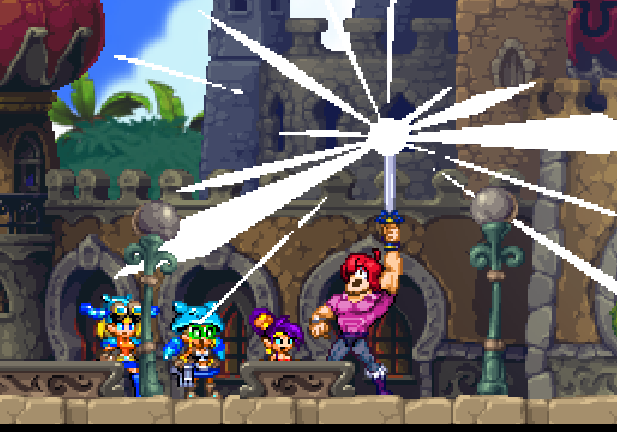
CHARGING INTO CLIFFS & WALLS:
Before explaining the next piratical gear piece, a minor complaint about the charge has to be mentioned.
Some collectibles can only be obtained by having Shantae charge into a cliff or wall. The latter will not be destroyed, of course, but somehow, this causes things that are off-screen to shake loose, dropping down from above. These things include gems and Cacklebats (more on these later).
This is perhaps intended for comical effect, and would have been quite funny if only the charge is easier to trigger. Rather, after having learned this, the player would try to smash Shantae into any wall or cliff by starting charges a few levels earlier, which can be a tedious thing to do. Worse, the player is not always rewarded for doing this, because some of the walls and cliffs do not yield anything.
CANNON:
Risky’s Revenge was a good platformer, but it had one glaring gap in its designs: there is no double jump. Pirate’s Curse would fill this gap and more in an entertaining manner with nothing less than Risky’s cannon (which was used against Shantae in the final boss fight of Risky’s Revenge).
Like how it was in the previous game, the cannon can fire multiple shots in quick succession; in the case of this game, it fires up to three. Somehow, Shantae can deploy the cannon in the middle of her regular jumps, and then fire the shots in order to use the recoil to move upwards. The player has just as much air control as when Shantae is making a regular jump. The cannon is “reloaded” as soon as Shantae’s feet touches solid ground again.
This means that Shantae can make quadruple-jumps, which is incredibly generous for a platformer. Furthermore, the shots fired by the cannon can damage enemies. Indeed, some enemies, such as the “ScorpGals” (to use WayForward’s own designation for them), are easier to defeat with the cannon jumps.
SHOP & GEMS:
Like Risky’s Revenge, there are gems to be collected from the loot that enemies drop when they are defeated. However, there is only a single currency this time around, and that is gems. There are no bottles of magical jams to be collected in this game. (It is something that certain NPCs would lament.)
There is a shop in Scuttle Town that sells consumables and upgrades in return for gems. Some upgrades will not appear for sale until after the player has obtained their associated pirate gear.
Considering that enemies can drop some consumable items, it might be more prudent for the player to gather these from enemies instead of buying them from the shop. Of course, there are items which could hardly be obtained from enemies, such as the aforementioned Pirate Flares.
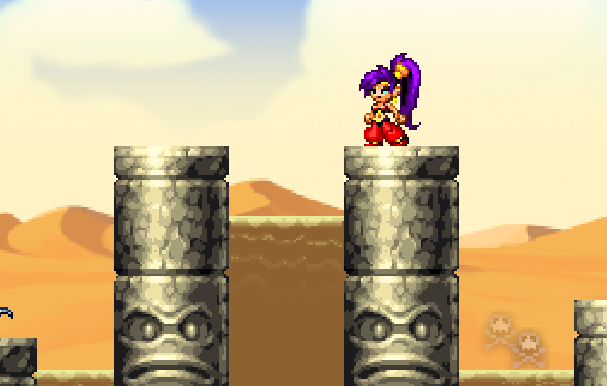
NEAR-IMPRACTICAL MOVES:
In addition to the pirate gear, Shantae has some moves that she can pull off without the use of any gear; these moves have to be bought from the shop, for whatever reason. (Presumably, they are the moves that Bolo taught to Shantae.)
Unfortunately, these moves are not very effective in practice.
Firstly, there is Recovery. As mentioned earlier, there are heavy hits that can fling Shantae a short distance away. Recovery is meant to restore the player’s control of Shantae. Unfortunately, its problem is that it does not negate the momentum of the fling; Shantae will continue to move in the direction that she is flung in during the recovery animation. The invincibility frames are extended, but only just over the recovery animations. It might be too late for the player to enter a control input to save her from falling into a death pit, or getting hit by other things.
Indeed, it might be more prudent for the player to avoid having Shantae struck by heavy hits in the first place.
Next, there is Heavy Kick. As its name suggests, Shantae delivers a powerful kick to whatever is in front of her. However, its animations take a while, during which she is vulnerable to attacks. More importantly, over the time of the animations of Heavy Kick, the player could have inflicted more damage with Shantae’s hair-whips.
Backdash was in Risky’s Revenge, and it returns in this game too. Unfortunately, it has been pared down a lot. To elaborate, there is a considerable delay between one backdash and the next, thus reducing its utility. The player is better off using jumps to get away from enemies, or put some distance between them and Shantae in the first place.
ENEMIES:
Some of the enemies appear to have returned from the previous games. In particular, there are the Archers, who have become a series staple mainly due to their turret-like behaviour (and likely their obvious endowments). Most of these enemies are there to serve the usual platforming challenges, such as turret-like enemies necessitating the timing of jumps from one platform to another.
However, some returning enemies are just dumb push-overs. These include the orcs (or goblins; it is not clear which they are supposed to be). They still patrol the platforms that they are on, and have the same silly and slow short-flight and stomp attack like they had in Risky’s Revenge. There are also the monocular spiders, which still suspend themselves from short thin lines and fire slow-moving, easily dodged projectiles. Such enemies are best bypassed entirely, if only to save time.
The other enemies are new, though not all of them are challenging. For example, there are the rats in the sewers underneath the Sequin Palace. Of course, they are rats, which in video game history, tend to be utter push-overs. There are also some new enemies which look nasty, but are otherwise worthless opponents. An example is the skull-faced automaton that appears in Propeller Town.
The challenging new ones include examples such as the hideously slimy creatures that appear on Bog Island. They require the player to look out for tell-tale pools of slime, from which they emerge.
Unlike the enemies in Risky’s Revenge, almost all enemies in Pirate’s Curse are endemic to whichever locale that they were first encountered. Apparently, this is due to a design decision that is intended to flesh out the world in the fiction of Shantae.
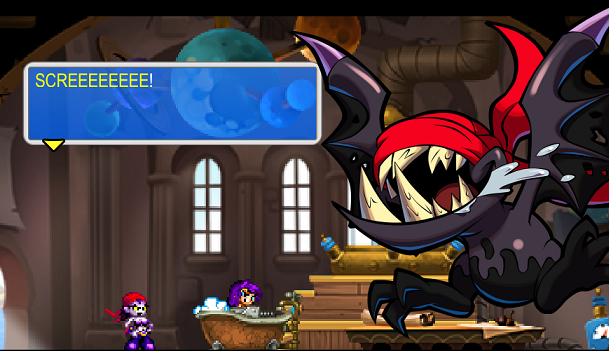
DARK MAGIC & CACKLEBATS:
At the end of the prologue, Risky reveals to Shantae the existence of a threat greater than Risky herself. This is portrayed through the hideous transformation of one of her Tinkerbats into a Cacklebat, a near-mindless flight-capable creature that is far removed from the furtive and silent Tinkerbat.
Afterwards, Shantae is tasked with tracking down the Cacklebats, each of which contains a little bit of dark magic. The Cacklebats are often located out of the way, behind obstacles that initially cannot be overcome.
Once they are discovered though, the Cacklebats are easily overcome. They are dim-witted push-overs, though they can take considerable damage before they release their dark magic. The dark magic can be gathered with the lamp (apparently the same lamp that was in Risky’s Revenge). Collecting all of the dark magic unlocks the canonical “good” ending for the game.
Amusingly, if the player fails to do so and gets the default non-canonical “bad” ending, the epilogue has dialogue text with specific words highlighted; they hint that the player should try again to collect all the dark magic.
Conveniently, the number of Cacklebats which can be found in a locale is shown in the sailing menu (which the player uses to transition to other islands).
BOSSES:
In Risky’s Revenge, most of the bosses have their own personalities and would become recurring characters. The most notable of these is the Squid Baron, who, in a fourth-wall-breaking tirade, accepts his role as a “filler boss” in Pirate’s Curse with aplomb.
Unfortunately, most of the other bosses in Pirate’s Curse are there to serve as pattern-bosses, and easy ones too. Some of them are even there for wordplay purposes, such as the “massively misspelled” “Dargon”, to quote the words that WayForward’s writers used. One of them continues the running gag that intelligent zombies like Rottytops use spiders for their “world-wide web” system of communication.
As mentioned earlier, the pirate gear that the player finds in the same locale that a boss is located in will be useful against that boss. It would not take long for a veteran Metrovania follower to figure out how to use them.
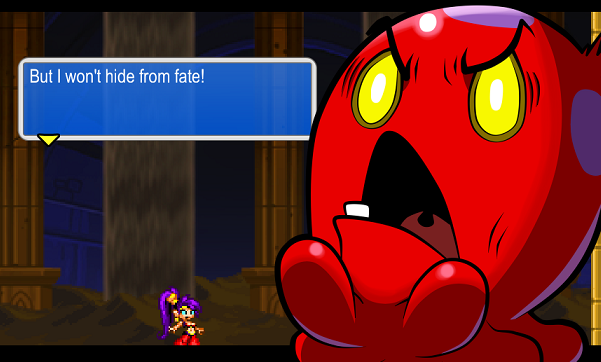
LEVEL GAMEPLAY DESIGNS:
As to be expected of levels in a Metrovania game, they are designed according to the player’s progress at gaining additional platforming capabilities and the player’s aptitude at using them.
As the player progresses through the game, the subsequent level designs compound obstacles together, often requiring the player to use a chain of two or more platforming abilities to get through them. The obstacles for the collectibles understandably require longer chains.
FAN-SERVICE CHAPTER:
Most levels allow the use of Shantae’s repertoire of capabilities without overt restrictions, but there is a chapter in the story where this is not the case. Incidentally, this chapter is the fan-service portion of the game, in which all of Shantae’s gear is removed and she has to change to a “Space Princess” outfit instead; the outfit is practically the amusingly skimpy metal-made costume that she had in the Magic Mode of the previous game.
This chapter is also where a stealth segment is implemented in the gameplay. Specifically, Shantae has to avoid the line-of-sight of armored guards, lest she is caught and escorted back to her bedchamber. Stealth-gameplay veterans would have no problems with such gameplay, especially after discovering that she can somehow hide in alcoves (despite how shiny her skimpy metal costume is).
On the other hand, the sudden imposition of stealth gameplay can be jarring. This is especially so for the parts where the player must strictly control the height of Shantae’s jumps in order to reach a platform below the platform on which a guard is stationed.
SHARPLY MORE CHALLENGING FINAL STRETCH:
In the finale of the story, Shantae has to navigate through a badly corrupted place that she had previously visited. This stretch of the playthrough will severely test the player’s competence at using the pirate gear, much more so than the platforming segments that lead to collectibles. A slip-up usually means a soft reset to the entrance of the current level.
The sharply different level of challenge can be unpleasant to some. This can seem even more so when one considers that the previous game did not have platforming challenges of such exactness.
CHARACTER DESIGNS:
As mentioned earlier, the story in Pirate’s Curse reveals more about the backstories of certain characters, especially Shantae and Risky. The exposition that is the most important to the canon of the IP occurs close to the finale of the game.
Some of the exposition has been made with silly humour in mind. For example, Sky’s parents are introduced in this entry as Relic Hunters. Like Uncle Mimic (who is also a Relic Hunter), they tend to bring back things of dubious value. There is also Sky’s mother’s eagerness to have Sky married to someone else, which is of no small embarrassment for Sky.
There is an important exposition on Rottytop’s past, but the exact details are still murky. On other hand, this part of the story is a convenient fan-service spot to show how she had looked like when she was alive.
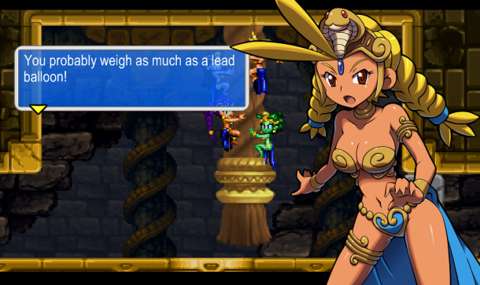
WRITING:
The writing in Pirate’s Curse would be mostly palatable to a seasoned story-goer. More importantly, characters have more lines this time around than they did in Risky’s Revenge, which goes some way to further flesh out their character, or at least remind the series’ followers of the personalities that had been established in the first game.
For example, there is Bolo’s fascination with attractive women (which are pretty much the majority of the populations of females in the fictitious world of Shantae). Where this is mostly absent in Risky’s Revenge, this is more noticeable in Pirate’s Curse, especially when he mentioned his encounter with Risky in the first game.
Some of the characters’ lines have unwitting innuendo slipped into them - Shantae’s, in particular (and sometimes Risky’s). For example, in a scene in which Shantae expresses dismay that the Royal Sequin Guard intend to cut off her hair, she refers to her hair as a “monstrous whipper”.
There are some less impressive pieces of writing though. For example, there is Shantae’s mixing up of pirate slang, which is cringe-inducing.
OCCASIONAL FREEZING:
Unfortunately, years on, The Pirate’s Curse is still not an entirely stable game. Seemingly random freezes can occur, albeit rarely.
For example, I have encountered a freeze when entering Cackle Tower for the first time; exiting and relaunching the game will not solve this problem. This was also encountered by a minority of players, upon doing some online search for the solution to this problem.
It was solved by restarting the computer, thus suggesting that the problem is an issue with its handling of computer memory.
VISUAL DESIGNS:
Since Shantae is using most of Risky’s practical gear, Risky sports a different look in this game. For example, she is wearing a bandanna instead of her skull-and-cross-bones tricorne hat. Of course, this different look might not be immediately noticeable if one has been looking at the other signature elements of Risky’s visual appearance.
Pirate’s Curse also marks the first time that non-pixelated hand-drawn artwork is used for sprites in the series. In particular, the sprites for the bosses make use of such artwork. The resulting mixture of pixel artwork and smooth-edged hand-drawn artwork can seem a tad odd, however. (This is perhaps why Half-Genie Hero does not make use of any pixel art.)
For better or worse, Pirate’s Curse reuses a lot of the assets in Risky’s Revenge. This is most notable for Shantae’s sprite. Although she has many new animations, a significant portion of her animations had already been seen in the previous game. The aforementioned returning enemies also use the same sprites that they had.
One can argue that WayForward is being a tad lazy (and this is indeed a criticism that WayForward took to heart, hence their project for Half-Genie Hero). Furthermore, this recycling makes Risky’s Revenge seem even more like a partially realized game that was prematurely finished, especially considering that Pirate’s Curse has far more locales to go to.
Speaking of which, the locales are represented as 2D planes, and all of them use square grids for their terrains and structures. However, their aesthetics do differ considerably. For example, Bog Island is visibly oozing all over, whereas Tan Line Island has gritty textures that try to make it clear that the island is composed of sand.
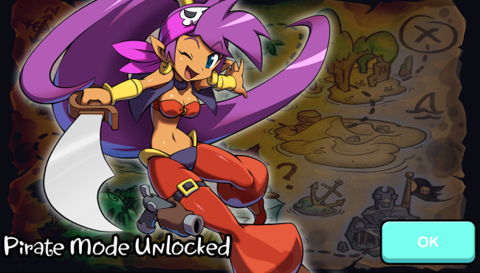
INTI CREATES ARTWORK:
Much of the artwork that is used for the dialogue scenes have been made by Inti Creates, a Japanese video game developer.
The artwork that they made has the most curves ever seen in the Shantae series, surpassing even those in the sequel Half-Genie Hero. This made the dialogue scenes look much more risqué than those in the other games, perhaps entertainingly so for people who do not mind that most of the curvaceous ladies are purportedly below 20 years of biological human age.
Nevertheless, this would greatly influence the dialogue artwork for the next game.
AUDIO DESIGNS:
Most of the sound effects in the game are either new or heavily remixed from those in Risky’s Revenge. They are mostly adequate for gameplay purposes.
There is the music, which is expectedly composed by Jake Kaufman. Since 2010, his composition has been increasingly more energetic, and this is audibly so in this game.
If the aesthetic designs of the islands are not enough to differentiate them already, each of the islands have their own music track. Particularly noteworthy tracks include “Scorching Dunes”, which start out stereotypically Arabyan before changing to a dance club tempo. (The soundtracks are separately included as bonus materials in the purchase of the game’s license.)
Occasionally, the music tracks or sound effects are suppressed for no discernible reason. Perhaps this was the consequence of attenuation scripting going awry.
Christina Vee provides most of the voices for the characters in the game, specifically the female ones that actually have voice-overs. Shantae, understandably, gets the most voice-overs; she sounds chippy, as befitting a feisty young tomboy.
CLOSING WORDS:
This entry of the series may have caused Risky’s Revenge to look like it is a prototype rushed to market. Yet, after so many years of doing side jobs of sometimes dubious quality and making games that are intended for touchscreens, Pirate’s Curse is a notable milestone in WayForward’s portfolio.

